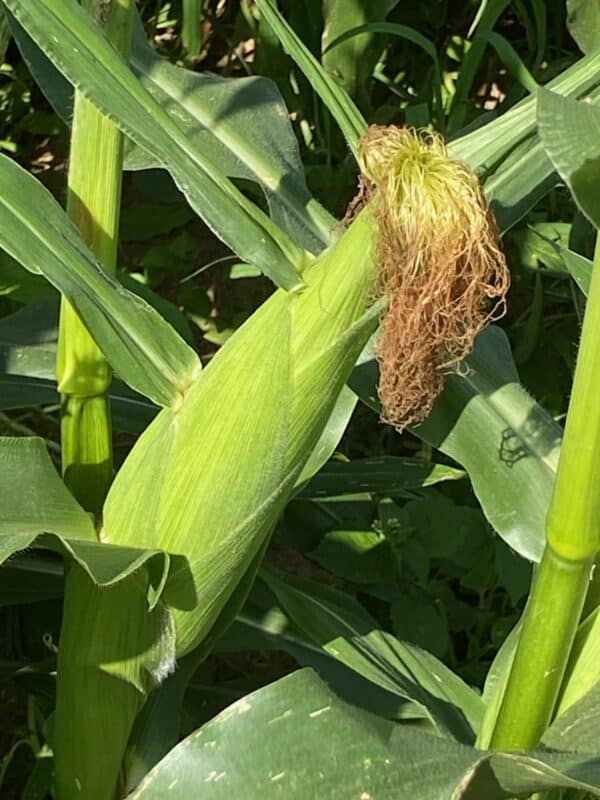
Few summer staple foods bring us as much joy as fresh sweet corn on the cob. But have you ever wondered how it comes to be? Turns out the perfect ear of corn is not the easiest thing to achieve, especially when growing it organically. But first, a little lesson on corn biology.
When the plant reaches sexual maturity, the tassel at the top (which is the male part of the flower) sheds millions of pollen grains which are carried by the wind and can be airborne for miles. The female portion of the corn flower is the ear, with silks that extend into the air to catch the falling pollen. Each silk is actually a tube that must catch a pollen grain, then migrate it through to the cob to fertilize the zygote, forming an individual kernel. If any of these silks are damaged a kernel will simply not form.
Sometimes the damage is naturally occurring – for example, in extremely hot and dry weather the silks can just dry out and shrivel up which prevents the pollen grain from going through to the cob properly. Other times there are silk-clipping pests that wreak havoc, such as Japanese Beetles and June bugs, that like to eat the fresh and tender silks at the root, severing the connection point for the pollen.
Being that we farm organically, it presents an extra challenge in that we do not use insecticides that would otherwise thwart these corn attackers so instead we rely on deterrents and protections. Funny enough we’ve figured out that mylar birthday balloons hung on 12 to 15 ft poles do an excellent job of scaring off the droves of blackbirds, who peck through the husk to get to the developing kernels. For the more savvy predators like raccoons, skunks, deer and coyotes (yes, you read that right!) we use temporary electric-net fencing.
That’s why we savor each and every ear we are able to harvest, knowing the effort it took to get there.
We get asked often how we like to enjoy our corn which is simply steamed with butter eaten straight off the cob. Below though you’ll find a recipe for our newest corn obsession, elote.
Adapted from Taste of Home
6 medium ears of sweet corn
1/4 cup sour cream
1/4 cup mayonnaise
1/4 cup minced fresh cilantro
1 teaspoon grated lime zest
2 tablespoons lime juice
2 garlic cloves, minced
6 tablespoons Cotija cheese
2 to 3 teaspoons chili powder
Carefully peel back the corn husks until they’re about 1 inch away from the bottoms. Remove the silk by either using a produce brush and brushing the silks away under running water or rubbing the cob with a gloved hand until the silk falls off.
Rewrap each ear of corn in its husk and secure with butcher’s twine. You need butcher’s twine for this step because it’s oven-safe—regular string won’t work. You don’t want to worry about anything burning while your corn is cooking.
In a Dutch oven, cover the corn with cold water. Let soak for 20 minutes and then drain.
While you’re waiting for the corn to soak, preheat your grill to medium heat (or 350°F). If you’re using a charcoal grill, cook the corn over direct heat. Place the corn on the grill and cover. Cook for 25 to 30 minutes, until the corn is tender, turning the ears of corn often.
In a medium bowl, combine the sour cream, mayonnaise, cilantro, lime zest, and juice. Peel back the husk on each ear of corn and spread the mixture generously over the kernels.
Sprinkle each ear of corn with Cotija cheese and chili powder and serve on a platter, or let everyone assemble an ear of corn so the toppings are to their liking. Elote is best served immediately so the mixture remains nice and warm on the crisp corn.



Made with 
